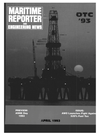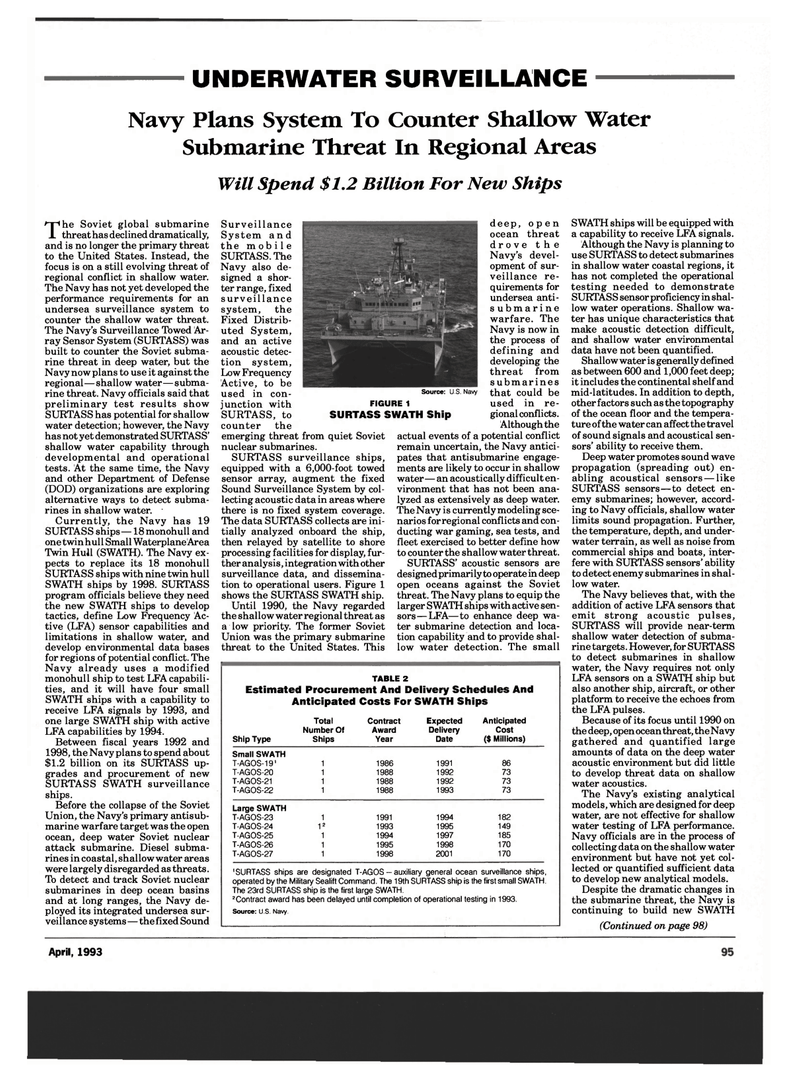
Page 93: of Maritime Reporter Magazine (April 1993)
Read this page in Pdf, Flash or Html5 edition of April 1993 Maritime Reporter Magazine
UNDERWATER SURVEILLANCE
Navy Plans System To Counter Shallow Water
Submarine Threat In Regional Areas
Will Spend $1.2 Billion For New Ships
The Soviet global submarine threat has declined dramatically, and is no longer the primary threat to the United States. Instead, the focus is on a still evolving threat of regional conflict in shallow water.
The Navy has not yet developed the performance requirements for an undersea surveillance system to counter the shallow water threat.
The Navy's Surveillance Towed Ar- ray Sensor System (SURTASS) was built to counter the Soviet subma- rine threat in deep water, but the
Navy now plans to use it against the regional—shallow water—subma- rine threat. Navy officials said that preliminary test results show
SURTASS has potential for shallow water detection; however, the Navy has not yet demonstrated SURTAS S' shallow water capability through developmental and operational tests. At the same time, the Navy and other Department of Defense (DOD) organizations are exploring alternative ways to detect subma- rines in shallow water. -
Currently, the Navy has 19
SURTASS ships —18 monohull and onetwinhull Small Waterplane Area
Twin Hull (SWATH). The Navy ex- pects to replace its 18 monohull
SURTASS ships with nine twin hull
SWATH ships by 1998. SURTASS program officials believe they need the new SWATH ships to develop tactics, define Low Frequency Ac- tive (LFA) sensor capabilities and limitations in shallow water, and develop environmental data bases for regions of potential conflict. The
Navy already uses a modified monohull ship to test LFA capabili- ties, and it will have four small
SWATH ships with a capability to receive LFA signals by 1993, and one large SWATH ship with active
LFA capabilities by 1994.
Between fiscal years 1992 and 1998, the Navy plans to spend about $1.2 billion on its SURTASS up- grades and procurement of new
SURTASS SWATH surveillance ships.
Before the collapse of the Soviet
Union, the Navy's primary antisub- marine warfare target was the open ocean, deep water Soviet nuclear attack submarine. Diesel subma- rines in coastal, shallow water areas were largely disregarded as threats.
To detect and track Soviet nuclear submarines in deep ocean basins and at long ranges, the Navy de- ployed its integrated undersea sur- veillance systems—the fixed Sound
Surveillance
System and the mobile
SURTASS. The
Navy also de- signed a shor- ter range, fixed surveillance system, the
Fixed Distrib- uted System, and an active acoustic detec- tion system,
Low Frequency
Active, to be used in con- junction with
SURTASS, to counter the emerging threat from quiet Soviet nuclear submarines.
SURTASS surveillance ships, equipped with a 6,000-foot towed sensor array, augment the fixed
Sound Surveillance System by col- lecting acoustic data in areas where there is no fixed system coverage.
The data SURTASS collects are ini- tially analyzed onboard the ship, then relayed by satellite to shore processing facilities for display, fur- ther analysis, integration with other surveillance data, and dissemina- tion to operational users. Figure 1 shows the SURTASS SWATH ship.
Until 1990, the Navy regarded the shallow water regional threat as a low priority. The former Soviet
Union was the primary submarine threat to the United States. This deep, open ocean threat drove the
Navy's devel- opment of sur- veillance re- quirements for undersea anti- submarine warfare. The
Navy is now in the process of defining and developing the threat from submarines that could be used in re- gional conflicts.
Although the actual events of a potential conflict remain uncertain, the Navy antici- pates that antisubmarine engage- ments are likely to occur in shallow water— an acoustically difficult en- vironment that has not been ana- lyzed as extensively as deep water.
The Navy is currently modeling sce- narios for regional conflicts and con- ducting war gaming, sea tests, and fleet exercised to better define how to counter the shallow water threat.
SURTASS' acoustic sensors are designedprimarily to operate in deep open oceans against the Soviet threat. The Navy plans to equip the larger SWATH ships with active sen- sors— LFA—to enhance deep wa- ter submarine detection and loca- tion capability and to provide shal- low water detection. The small
SWATH ships will be equipped with a capability to receive LFA signals.
Although the Navy is planning to use SURTASS to detect submarines in shallow water coastal regions, it has not completed the operational testing needed to demonstrate
SURTASS sensor proficiency in shal- low water operations. Shallow wa- ter has unique characteristics that make acoustic detection difficult, and shallow water environmental data have not been quantified.
Shallow water is generally defined as between 600 and 1,000 feet deep; it includes the continental shelf and mid-latitudes. In addition to depth, other factors such as the topography of the ocean floor and the tempera- ture of the water can affect the travel of sound signals and acoustical sen- sors' ability to receive them.
Deep water promotes sound wave propagation (spreading out) en- abling acoustical sensors — like
SURTASS sensors—to detect en- emy submarines; however, accord- ing to Navy officials, shallow water limits sound propagation. Further, the temperature, depth, and under- water terrain, as well as noise from commercial ships and boats, inter- fere with SURTASS sensors' ability to detect enemy submarines in shal- low water.
The Navy believes that, with the addition of active LFA sensors that emit strong acoustic pulses,
SURTASS will provide near-term shallow water detection of subma- rine targets. However, for SURTASS to detect submarines in shallow water, the Navy requires not only
LFA sensors on a SWATH ship but also another ship, aircraft, or other platform to receive the echoes from the LFA pulses.
Because of its focus until 1990 on the deep, open ocean threat, the Navy gathered and quantified large amounts of data on the deep water acoustic environment but did little to develop threat data on shallow water acoustics.
The Navy's existing analytical models, which are designed for deep water, are not effective for shallow water testing of LFA performance.
Navy officials are in the process of collecting data on the shallow water environment but have not yet col- lected or quantified sufficient data to develop new analytical models.
Despite the dramatic changes in the submarine threat, the Navy is continuing to build new SWATH (Continued on page 98)
TABLE 2
Estimated Procurement And Delivery Schedules And
Anticipated Costs For SWATH Ships
Total Contract Expected Anticipated
Number Of Award Delivery Cost
Ship Type Ships Year Date ($ Millions)
Small SWATH
T-AGOS-19' 1 1986 1991 86
T-AGOS-20 1 1988 1992 73
T-AGOS-21 1 1988 1992 73
T-AGOS-22 1 1988 1993 73
Large SWATH
T-AGOS-23 1 1991 1994 182
T-AGOS-24 12 1993 1995 149
T-AGOS-25 1 1994 1997 185
T-AGOS-26 1 1995 1998 170
T-AGOS-27 1 1998 2001 170 'SURTASS ships are designated T-AGOS - auxiliary general ocean surveillance ships, operated by the Military Sealift Command. The 19th SURTASS ship is the first small SWATH.
The 23rd SURTASS ship is the first large SWATH. 2Contract award has been delayed until completion of operational testing in 1993.
Source: U S Navy.
Source: U.S. Navy
FIGURE 1
SURTASS SWATH Ship
April, 1993 111

 92
92

 94
94
